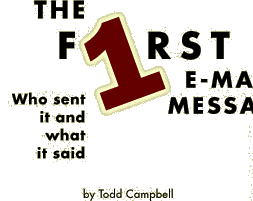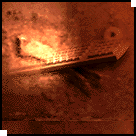The First Email Message


|
Three, maybe four times in recent history, a new technology has been introduced that has fundamentally transformed human society by changing the way people communicate with each other. For the most part, the moment in which these new technologies came into being are preserved with a kind of clarity and drama that is both thrilling and unforgettable. There is Samuel B. Morse and the first telegram. Delivered on May 24, 1844, the message read "What hath god wrought!" Morse knew that he was making history. And there was the dawn of the telephone era, heralded by Alexander Graham Bell's less grand, though still legendary, summons to his assistant on March 10, 1876: "Mr. Watson, come here; I want you." While the exact wording of Guglielmo Marconi's first wireless transmission in 1895 is not the stuff of legend, it didn't take long for Marconi to be heaped with honors and awards, topped off by a Nobel Prize for physics in 1909. And even 30 years later the inauguration of wireless service between England and South Africa felt like an historic event to the participants. "We speak across time and space. . . . May the new power promote peace between all nations," read the Marconigram sent from Sir Edgar Walton, high commissioner of South Africa, to General J. B. M. Hertzog, South Africa's prime minister, in 1924. Sometime in late 1971, a computer engineer named Ray Tomlinson sent the first e-mail message. "I sent a number of test messages to myself from one machine to the other," he recalls now. "The test messages were entirely forgettable. . . . Most likely the first message was QWERTYIOP or something similar." It seems doubtful that "QWERTYIOP" will make it into the history books. And Tomlinson's name hardly lives in the public mind. When he is remembered at all, it is as the man who picked @ as the locator symbol in electronic addresses. In truth though, he is the inventor of e-mail, the application that launched the digital information revolution. And yet the breakthrough he made was such a simple evolutionary step that hardly anyone noticed it till later. At the time, it barely registered with Ray Tomlinson. How it Happened Tomlinson worked for Bolt Beranek and Newman (BBN), the company hired by the United States Defense Department in 1968 to build ARPANET, the precursor to the Internet. In 1971 he was tinkering around with an electronic message program called SNDMSG, which he had written to allow programmers and researchers who were working on Digital PDP-10s—one of the early ARPANET computers—to leave messages for each other. But this was not e-mail, exactly. Like a number of then existing electronic message programs, the oldest dating from the early 1960s, SNDMSG only worked locally; it was designed to allow the exchange of messages between users who shared the same machine. Such users could create a text file and deliver it to a designated "mail box." "A mailbox was simply a file with a particular name," Tomlinson later wrote. "Its only special property was . . . [users] could write more material onto the end of the mailbox, but they couldn't read or overwrite what was already there." When Tomlinson sat down to play around with SNDMSG, he had been working on an experimental file transfer protocol called CYPNET, for transferring files among linked computers at remote sites within ARPANET. (At the time, the ARPANET consisted of 15 nodes, located at places like UCLA in California, the University of Utah in Salt Lake City, and at BBN in Cambridge, Massachusetts.) "The idea occurred to me that CYPNET could append material to a mailbox file as readily as SNDMSG could," explained Tomlinson. The way CYPNET was originally written, it sent and received files, but had no provision for appending to a file. So he set out to adapt CYPNET to use SNDMSG to deliver messages to mailboxes on remote machines, through the ARPANET. "Adding the missing piece was a no-brainer," according to Tomlinson. "Just a minor addition to the protocol." What Tomlinson did next, if he had fully grasped its significance, might have earned him a place alongside the giants of communication history. First, he chose the @ symbol to distinguish between messages addressed to mailboxes in the local machine and messages that were headed out onto the network. "The @ sign seemed to make sense," he recalled. "I used the @ sign to indicate that the user was 'at' some other host rather than being local." Then he sent himself an e-mail message. BBN had two PDP-10 computers wired together through the ARPANET. "The first message was sent between two machines that were literally side-by-side. The only physical connection they had, however, was through the ARPANET," according to Tomlinson. The message flew out via the network between two machines in the same room in Cambridge; and the message was QWERTYIOP. Or something like that. A Natural Phenomenon Once Tomlinson was satisfied that SNDMSG worked on the network, he sent a message to colleagues letting them know about the new feature, with instructions for placing an @ in between the user's login name and the name of his host computer. "The first use of network mail," says Tomlinson, "announced its own existence." Tomlinson's new program almost instantly became the first killer app. "After we delivered the enhanced version of SNDMSG to other sites, (so that there was someone out there to talk to) virtually all my communication was via e-mail," he remembers. Two years later, a study found that 75 percent of all traffic on ARPANET was e-mail. But if it caught on like wildfire, it somehow managed to do so almost without notice. For the engineers and scientists who quickly adopted it as the preferred mode of day-to-day communications, it mostly felt like a logical outgrowth of the development of ARPANET. In fact, it took almost five years for the builders and designers of ARPANET to sit back and realize that in many ways, e-mail had become the real raison d'etre for the new computer network. "A surprising aspect of the message service is the unplanned, unanticipated, and unsupported nature of its birth and early growth," reads a report on e-mail written for ARPA in 1976. "It just happened, and its early history has seemed more like the discovery of a natural phenomenon than the deliberate development of a new technology." One reason that it was adopted so quickly was that it perfectly suited the communications needs and style of the engineers who built ARPANET. In a paper published in 1978 by the Institute of Electrical and Electronic Engineers, two of the important figures in the creation of the ARPANET, J. C. R. Licklider and Albert Vezza, explained the popularity of e-mail. "One of the advantages of the message systems over letter mail was that, in an ARPANET message, one could write tersely and type imperfectly, even to an older person in a superior position and even to a person one did not know very well, and the recipient took no offense. . . . Among the advantages of the network message services over the telephone were the fact that one could proceed immediately to the point without having to engage in small talk first, that the message services produced a preservable record, and that the sender and receiver did not have to be available at the same time." A report released that same year provides one of the earliest indications that ARPANET developers were beginning to realize precisely what they had created: "There is little doubt that the techniques of network mail developed in connection with the ARPANET program are going to sweep the country and drastically change the techniques used for intercommunication in the public and private sectors." Tomlinson Looks Back Tomlinson still works at BBN, which was acquired last year by GTE. A principal engineer for BBN, he is currently working on a project that involves "developing an architecture for quickly building distributed information integration and visualization tools." In the nearly three decades that have elapsed since he invented e-mail, he has worked on everything from network protocols to supercomputer design. Recently, Tomlinson answered a few questions about his role as the inventor of e-mail. The interviews were conducted, appropriately enough, through e-mail. Asked what inspired his invention, his response comes back as undramatic as the event itself: "Mostly because it seemed like a neat idea," he writes. "There was no directive to 'go forth and invent e-mail.'" Like many of the men involved in the creation of APRANET, he looks back on the late 1960s and early 1970s as a golden age in both computer research and their own careers. "I agree that that era was particularly productive for ARPA and its contractors," he writes, "The emphasis was on 'advanced research' and high-risk, high-payoff projects were the norm. That emphasis has eroded over time and there is less risk-taking . . . things are not as exciting today." Finally, what of his place in history? Morse, Bell, Marconi. And Tomlinson? "The pace [of progress] has accelerated tremendously since the [names] you mention. This means that any single development is stepping on the heels of the previous one and is so closely followed by the next that most advances are obscured," writes the inventor of e-mail, modestly. "I think that few individuals will be remembered." But he hasn't quite given up hope. "I am curious to find out if I am wrong," he adds. |